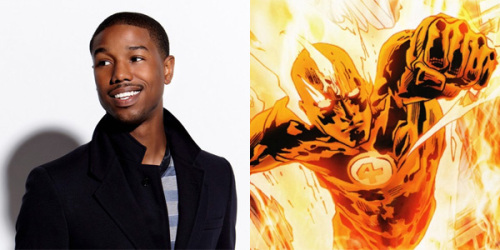
Yesterday, I wrote about the news that Michael B. Jordan (Fruitvale Station, Chronicle) would be adopting the mantle of The Human Torch. I talked about my enthusiasm for integrating diverse story-telling into comics, and my reservations that trans-racial casting in the absence of varied and complex writing is literally skin-deep diversity.
On the other side of the argument, some have celebrated Jordan’s casting, arguing that cross-racial casting of major superhero properties is the path of least resistance towards the goal of diverse superheroes. They argue that the road towards introducing superheroes of colour to the major publishing houses — DC and Marvel — is rife with red tape obstacles; the solution, therefore, is to encourage the seamless and casual transracialization of existing characters.
I disagree.
If the purpose of diversifying comics is to introduce minority fans to relatable superheroes, then while seeing an empowered brown body shoot lasers from her eyes is fun, seeing an empowered brown body shoot lasers from her eyes and who is also brown when she takes her cape off is far more relatable. Cross-racial casting doesn’t dismantle the pretenses of an industry that has since time immemorial treated race like window-dressing while it is also viewed as an unseemly subject best left out of comics. When comic writers and publishing houses are encouraged in the fantasy that writing a superhero is race-neutral until an artist puts blue pencil to paper (or a casting director taps a talented non-White actor to play the part) it perpetuates a system that has historically ignored, disrespected, and devalued Blackness and race in general.
If we want to inject diversity into comics, the solution isn’t to offer the appearance of race while ignoring its impact on the people behind the mask. The solution is to tackle race head-on.
Want an example? Meet Grace Choi.
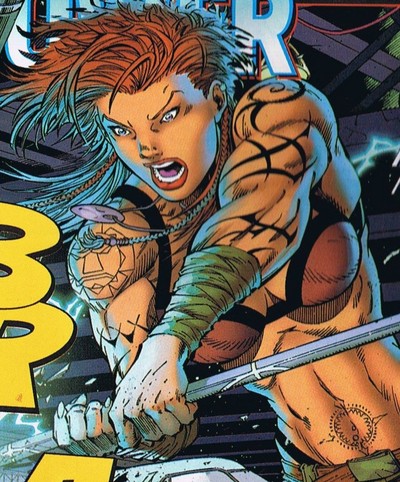
Grace Choi is the brain-child of Judd Winick and Tom Raney. Standing at well-over 6 feet tall and all brawn, Grace slams both fists through the stereotype of the Chinese American woman. She is tattooed and sports a poof of dyed red hair. She irreverently drinks, carouses, and fucks. She is unapologetically bisexual. In short, she is many things that many Asian and Asian American women are, and everything Asian and Asian American women are stereotypically not. In so doing, she at once dismantles the stereotype of the lithe, soft-spoken, samurai-sword-wielding Asian superheroine (most directly embodied by her Outsider team-mate Katana), and more importantly, is painfully aware of her status as a stereotype-buster.
Yes, that’s right: to understand Grace Choi is to understand that she is both a fully-formed character in her right, but one that is informed by her identity as an Asian American woman. She is Asian American not just because of how she looks, but more importantly, based on how she is written. Grace’s personality stands on its own — rarely does she have an explicit race moment — but is nonetheless layered by the silent existence of an Asian American community and femininity that rejects her. In short, you don’t need a conversation about Asian American identity to understand Grace Choi, but it certainly helps.
Later, the revelations that she is (spoiler) an Amazon produces an interesting commentary on race relations in the Amazonian culture (wherein Themyscirans, but not some of Grace’s Bana ancestors, enjoy White privilege). Grace’s integrated identity as an Asian American woman also inspires two major story arcs for her character that ground her character in significant real-world Asian American issues: 1) her origin as a survivor of a human trafficking ring explores the impact of the illegal sex trade on Asian and Asian American women, and 2) her ongoing, and stable relationship with fellow team-mate Anissa Pierce (Thunder) provides one of DC’s most stable and long-lasting gay relationships, and it’s the first (to my knowledge) interracial queer couple involving two people of colour in those pages; Grace’s unapologetic relationship to her sexuality contrasted to Anissa’s hesitation speaks to several topics relevant to queer people of colour.
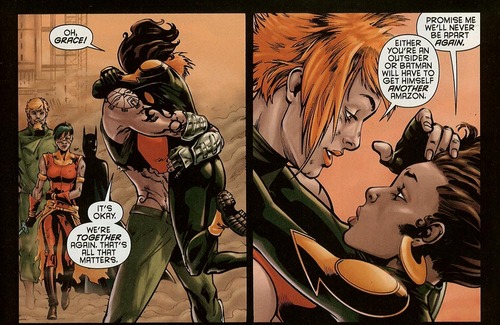
I love Jubilee, but if you were to ask me who the most powerful and meaningfully Asian American character comics is, I would easily respond with Grace Choi.
Further, Grace Choi proves that a writer who writes a character of colour with race in mind can accomplish some truly outstanding work. Grace’s identity as an Asian American woman is a living, breathing part of who she is, but she’s also so much more than that. As an Asian American reader, I found in Grace both the chance to explore my identity and to do so in a multi-faceted character who fully embodies the idea of intersectionality.
Grace Choi is what a writer can do when he invents a brand new character of colour, and uses her to explore identity (racial or otherwise). Grace is everything that you can’t accomplish with a quick trans-racialization of a popular pre-existing superhero property by a lazy writer who’d rather write in the absence of race.
Yes, I said it: the post-racial world cultivated in a lot of popular speculative fiction, and in mainstream comics, is lazy writing disguised as a progressive utopia that is virtually unrecognizable to real kids (of colour or not). A writer writing about the appearance (but not the substance) of race in a racial vacuum is capable of shielding his work — and therefore his thinking — from the complexity of what race identity really means. Not surprisingly, post-racial fantasy worlds have almost always been the product of White creators — think Gene Roddenberry. Fans protect these post-racial fantasies in no small part because they implicitly assert that race is only uncomfortable when we talk about it. Remember how angry fans became when Avery Brooks, and the unapologetic Blackness of Captain Sisko, broke the fourth wall of Star Trek’s post-racial bubble by reminding viewers that Blackness matters as a course of self-identity; by the end of Deep Space Nine, Sisko’s Blackness was no longer scenery, and many fans revolted.
But, I think this is not only destructive to comic diversity, it’s also destructive to the quality of comic writing. When comic writers are allowed to avoid the impact of race on the formation of self-identity, they shortcut an entire broad landscape of writing, and short-change the many young nerds of colour who could most relate to a discussion of what race means to their favourite superheroes. That’s why Grace Choi will always be a far more meaningful Asian American superhero to me than Jubilee — Grace Choi lives in a small pocket of the DC universe where her Asian American identity exists; Jubilee lives in Marvel’s world where her racial minority status is largely ignored.
Now, my critics will argue (and rightfully so) that Grace never really made it big in the ranks of DC Comics. It’s true: after her run with the Outsiders, Grace appeared as a minor character in a few cross-over events, in the pages of Wonder Woman, and then she “retired” to live out her life with Anissa.
So, they ask: “how do we take a popular superhero and make him or her a minority?” This leaves us with the solution of trans-racialization, but it also assumes that the popularity of superheroes is static and unchanging. Maybe the better question is: “how do we take a superhero of colour, and make him or her popular?”
Grace’s lack of popular success is not evidence that the “new character” route is a bad one. In fact, I think she’s evidence that new characters of colour are viable, as long as they are supported by great writers willing to do the hard work to routinely use them to write good stories. If Grace suffered from anything, it was from writer abandonment when Winick moved on from Outsiders, and became essentially an orphaned character in the DC pantheon.
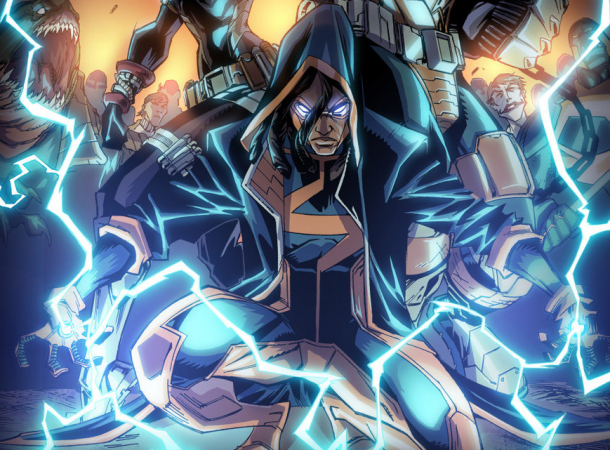
But there’s a great example of the success that can come when a “new character” of colour is nurtured for years by their creator. During his career, Dwayne McDuffie created a vast array of novel African American characters, and used Milestone Comics to breathe life into them; more importantly, he used Milestone to write a superhero world where race (and racism) exists for his characters to inhabit, allowing each of his characters to explore some aspect of Black identity. His unending attention yielded at least three major African American superheroes that have since risen to prominence: Icon (a Superman pastiche), Rocket, and Static Shock all have appeared in major DC cartoon films, comics, and videogames as major supporting characters after Milestone was acquired by DC. Now also orphaned following McDuffie’s untimely passing, these characters may also suffer the fate of Grace Choi, but McDuffie’s work proved that completely new characters wearing completely new superhero identities are indeed viable as mainstream-able and marketable properties.
Still other new characters of colour have already been invented in both the major comic book houses — Aqualad, Cassandra Cain, Kamala Khan, Miles Morales, — and while one hopes that the right writing treatment will further enhance the use of these characters as vehicles for exploring race and identity among other topics, all four have already won themselves a hefty fanbase among fans of all races. At least one has done so without (yet) needing the mantle of a major superhero to attract readers.
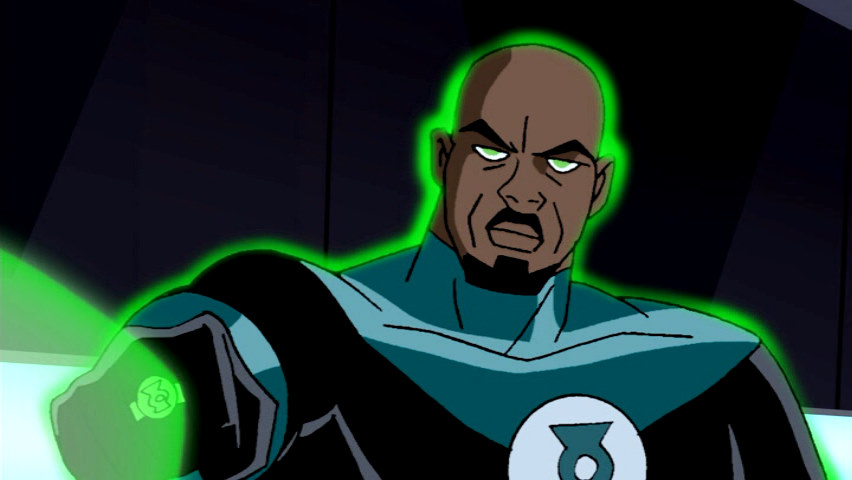
McDuffie’s second contribution to the project of diversifying comics was to demonstrate how existing Black characters can be repatterned to either add complexity and/or take them away from their disturbing race politics roots to create popular and viable fresh properties. Tasked with writing for the highly popular JLA/JLU cartoon series, McDuffie repurposed several African American characters, and made them some of the most popular characters on the show. John Stewart’s Green Lantern, for example, became the most visible face of the Green Lantern mantle for nearly a decade, and who ever thought Vixen would ever be cool? Both characters rose to prominence in those shows while simultaneously being grounded in their Blackness as one of several facets of their characters. Indeed, the only reason why the DC trinity (Batman, Superman, and Wonder Woman ) have such prominence is through the combination of tradition and the work of writers to elevate them to the forefront; there’s no reason why consistent effort — some of it already accomplished by McDuffie — couldn’t build a similar place of prominence for a character like John Stewart’s Green Lantern.
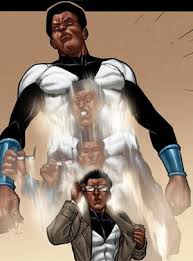
Furthermore, while the current mainstream comics pantheon contain a mish-mash of one-dimensional Black superheroes created during a historically segregationist era and whose Blackness basically defines them — Luke Cage, Black Lightning, Black Goliath, etc — it’s not hard to imagine how a McDuffie treatment of some of these existing properties couldn’t also yield the same results as McDuffie found with John Stewart.
Returning to the cross-racial casting of Johnny Storm, none of this says that reimagining major superhero properties as people of colour should be shunned or frowned upon. Indeed, the success of the Samuel L. Jackson-inspired Nick Fury and the Chinese American Wasp — both of the Ultimates universe — indicate that the frequent full-universe reboot mechanism of both major publishing houses can yield new interpretations of existing superheroes that will be accepted by fans. These reboots (which is what the upcoming Fantastic Four film also represents) are a nice vehicle for reinterpreting existing superheroes with integrated minority identities. But, importantly, all our aforementioned examples of transracialization of popular characters in rebooted universes are deliberate changes that happened at the writing stage, to specifically introduce distinct people (with distinct personalities informed by their minority status) even while wearing familiar names. None were transracialized at the art stage.
If Michael B. Jordan’s casting as The Human Torch is treated with the same care and dignity as Dwayne McDuffie offered in writing the Blackness of his new and repurposed superheroes, than great. But I think McDuffie would turn in his grave at the thought of swift and careless cross-racial casting of a Black actor into a traditionally White role. Instead, I think he would advocate that authentic minority characters are only achieved through the consistent work of considering race and Blackness, and introducing those ideas (subtly perhaps) into both the characters and the world they inhabit.
Either way, I reject the notion that simple transracialization of popular heroes is the only way to comic diversity (though, granted, it may be the easiest; but I would argue also the least authentic). History has shown other, and arguably better in some regards, mechanisms for injecting diversity into comics, through the use of new and repurposed characters.
Nerds of colour who seek to inject diversity in comics would do well to spend more time thinking not just about our desired end-game, but the institutional barriers of the comics industry that have historically blocked these efforts. We must think not just about band-aid solutions but paradigm shifts in how creators write comics and how readers approach them. And while I don’t wholly reject the (careful) transracialization of traditionally White characters, it should be one tool in our toolbox, not the entire toolbox itself.
Personally, I’d rather support the efforts of talented minority creators — some of whom could be the next McDuffie — than constantly look to DC and Marvel to potentially screw up something that independent writers have been doing well for decades.
